Xinze Lyu
Redefining Machine Translation on Social Network Services with Large Language Models
Apr 10, 2025Abstract:The globalization of social interactions has heightened the need for machine translation (MT) on Social Network Services (SNS), yet traditional models struggle with culturally nuanced content like memes, slang, and pop culture references. While large language models (LLMs) have advanced general-purpose translation, their performance on SNS-specific content remains limited due to insufficient specialized training data and evaluation benchmarks. This paper introduces RedTrans, a 72B LLM tailored for SNS translation, trained on a novel dataset developed through three innovations: (1) Supervised Finetuning with Dual-LLM Back-Translation Sampling, an unsupervised sampling method using LLM-based back-translation to select diverse data for large-scale finetuning; (2) Rewritten Preference Optimization (RePO), an algorithm that identifies and corrects erroneous preference pairs through expert annotation, building reliable preference corpora; and (3) RedTrans-Bench, the first benchmark for SNS translation, evaluating phenomena like humor localization, emoji semantics, and meme adaptation. Experiments show RedTrans outperforms state-of-the-art LLMs. Besides, RedTrans has already been deployed in a real-world production environment, demonstrating that domain-specific adaptation, effectively bridges the gap between generic and culturally grounded translation systems.
Rate-Splitting Multiple Access for Integrated Sensing and Communications: A First Experimental Study
Dec 16, 2024Abstract:A canonical use case of Integrated Sensing and Communications (ISAC) in multiple-input multiple-output (MIMO) systems involves a multi-antenna transmitter communicating with $K$ users and sensing targets in its vicinity. For this setup, precoder and multiple access designs are of utmost importance, as the limited transmit power budget must be efficiently directed towards the desired directions (users and targets) to maximize both communications and sensing performance. This problem has been widely investigated analytically under various design choices, in particular (a) whether or not a dedicated sensing signal is needed, and (b) for different MIMO multiple access techniques, such as Space Division Multiple Access (SDMA) and Rate-Splitting Multiple Access (RSMA). However, a conclusive answer on which design choice achieves the best ISAC performance, backed by experimental results, remains elusive. We address this vacuum by experimentally evaluating and comparing RSMA and SDMA for communicating with two users $(K = 2)$ and sensing (ranging) one target. Over three scenarios that are representative of \emph{vehicular} ISAC, covering different levels of inter-user interference and separation/integration between sensing and communications, we show that RSMA without a dedicated sensing signal achieves better ISAC performance -- i.e., higher sum throughput (upto $50\%$ peak throughput gain) for similar radar SNR (between $20$ to $24{\rm dB}$) -- than SDMA with a dedicated sensing signal. This first-ever experimental study of RSMA ISAC demonstrates the feasibility and the superiority of RSMA for future multi-functional wireless systems.
Rate-Splitting Multiple Access for Overloaded Multi-group Multicast: A First Experimental Study
Jun 21, 2024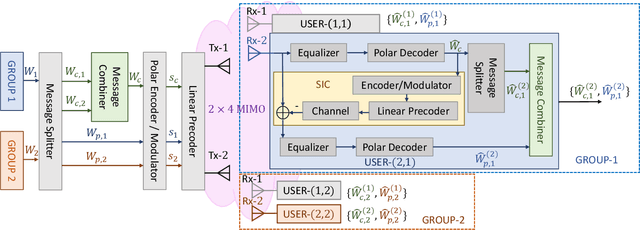
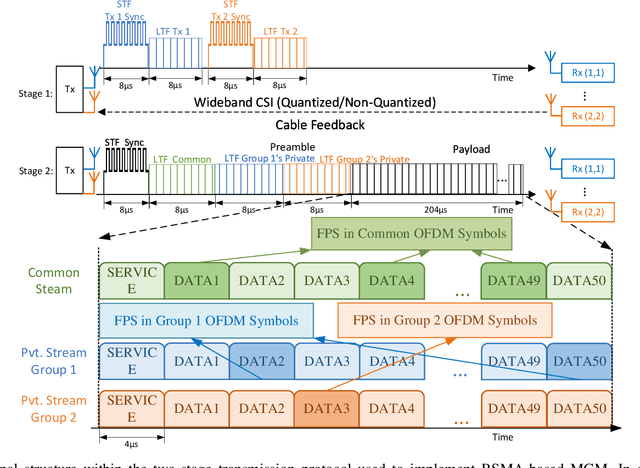
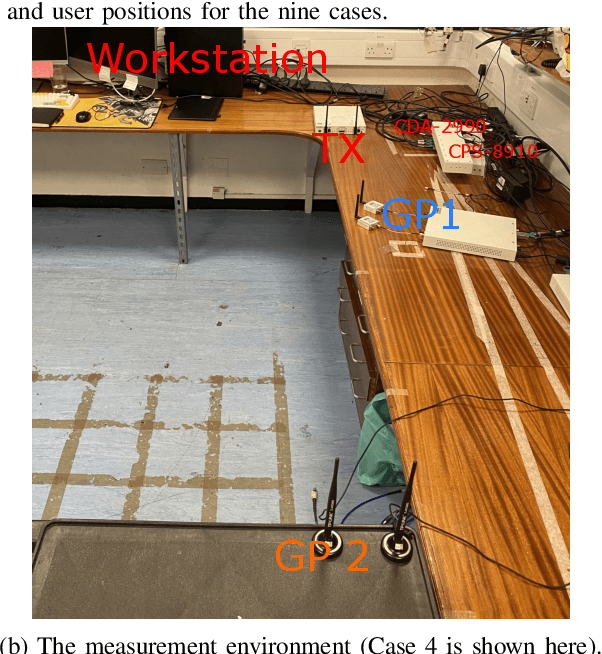
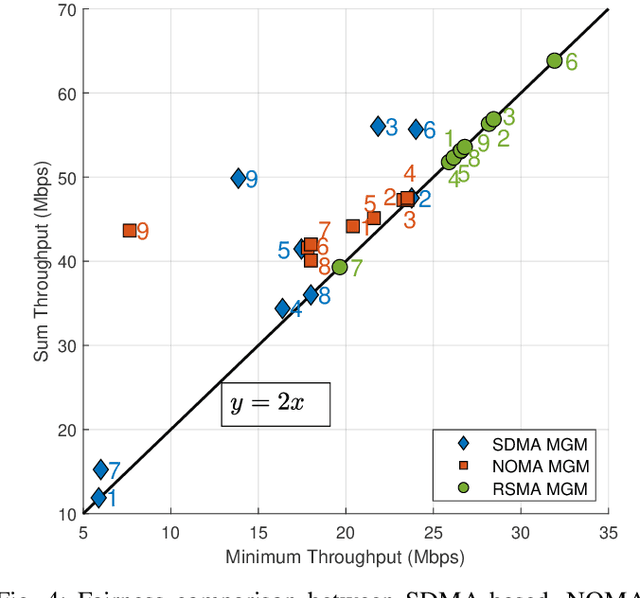
Abstract:Multi-group multicast (MGM) is an increasingly important form of multi-user wireless communications with several potential applications, such as video streaming, federated learning, safety-critical vehicular communications, etc. Rate-Splitting Multiple Access (RSMA) is a powerful interference management technique that can, in principle, achieve higher data rates and greater fairness for all types of multi-user wireless communications, including MGM. This paper presents the first-ever experimental evaluation of RSMA-based MGM, as well as the first-ever three-way comparison of RSMA-based, Space Divison Multiple Access (SDMA)-based and Non-Orthogonal Multiple Access (NOMA)-based MGM. Using a measurement setup involving a two-antenna transmitter and two groups of two single-antenna users per group, we consider the problem of realizing throughput (max-min) fairness across groups for each of three multiple access schemes, over nine experimental cases in a line-of-sight environment capturing varying levels of pathloss difference and channel correlation across the groups. Over these cases, we observe that RSMA-based MGM achieves fairness at a higher throughput for each group than SDMA- and NOMA-based MGM. These findings validate RSMA-based MGM's promised gains from the theoretical literature.
Rate-Splitting Multiple Access for Non-Orthogonal Unicast Multicast: An Experimental Study
Apr 12, 2024Abstract:Non-orthogonal unicast multicast (NOUM) is a variant of multi-antenna multi-user communications where the users desire a shared message (multicast) in addition to their respective unique messages (unicast). The multicast rate is capped in many emerging NOUM applications, such as live-event broadcasting, location-based services and vehicular communications. Given this constraint, we experimentally show that when the user channels are highly correlated, Rate-Splitting Multiple Access (RSMA)-based NOUM can meet the multicast rate while supporting a larger unicast sum rate than conventional multi-user linear precoding (MULP)-based NOUM.
A Prototype Implementation of Rate Splitting Multiple Access using Software-Defined Radios
May 12, 2023Abstract:For interference-limited multi-user communications, many papers have demonstrated, in theory, the effectiveness of Rate Splitting Multiple Access (RSMA) in suppressing the interference and achieving better outcomes (w.r.t spectral efficiency, fairness etc.) than the conventional Space Division Multiple Access (SDMA) used in present-day standards. However, an experimental demonstration of RSMA's benefits is missing in the literature. In this paper, we address this gap by realizing an RSMA prototype using software-defined radios. For the two-user multiple-input single-output (MISO) scenario, we measure the throughput performance of SDMA and RSMA in nine different scenarios that vary in terms of the channel pathloss and spatial correlation experienced by the users. Emulating perfect channel state information (CSI) at the transmitter through unquantized CSI feedback, we observe that RSMA achieves a higher sum throughput (upto 57%) and more fairness than SDMA when the user channels have high spatial correlation. Similarly, emulating imperfect CSI through quantized feedback, RSMA - along with the above trend - also experiences a smaller sum throughput loss, relative to the unquantized case (37%, on average, as opposed to 44% for SDMA). These outcomes are consistent with theoretical predictions, and demonstrate the feasibility and potential of RSMA for next generation wireless networks (e.g., 6G).
Rule-Guided Graph Neural Networks for Recommender Systems
Sep 09, 2020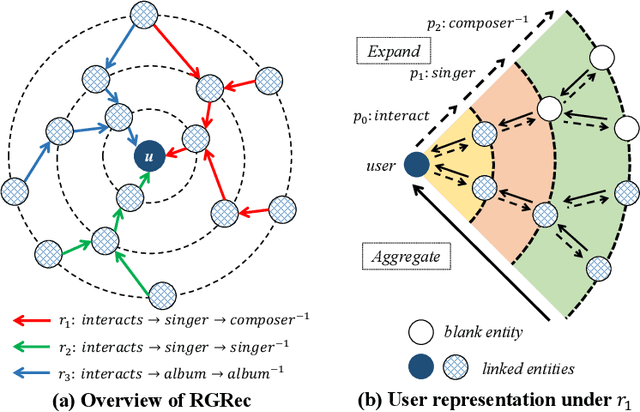
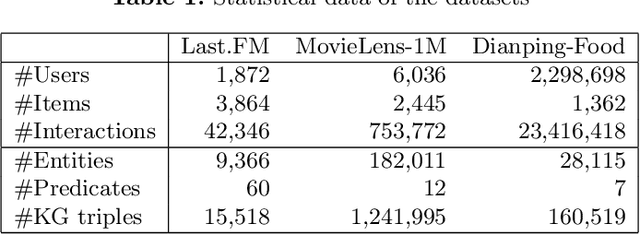
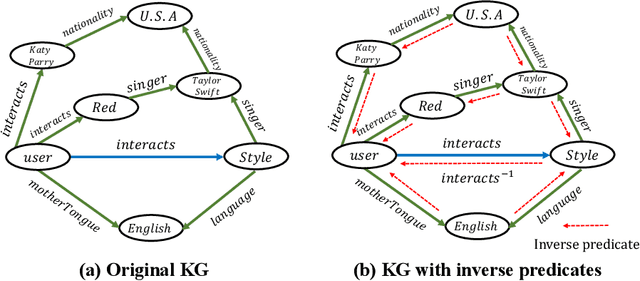
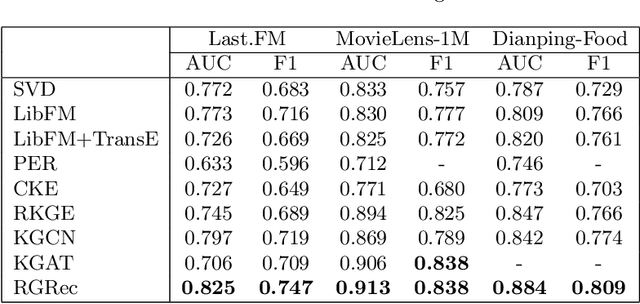
Abstract:To alleviate the cold start problem caused by collaborative filtering in recommender systems, knowledge graphs (KGs) are increasingly employed by many methods as auxiliary resources. However, existing work incorporated with KGs cannot capture the explicit long-range semantics between users and items meanwhile consider various connectivity between items. In this paper, we propose RGRec, which combines rule learning and graph neural networks (GNNs) for recommendation. RGRec first maps items to corresponding entities in KGs and adds users as new entities. Then, it automatically learns rules to model the explicit long-range semantics, and captures the connectivity between entities by aggregation to better encode various information. We show the effectiveness of RGRec on three real-world datasets. Particularly, the combination of rule learning and GNNs achieves substantial improvement compared to methods only using either of them.
 Add to Chrome
Add to Chrome Add to Firefox
Add to Firefox Add to Edge
Add to Edge